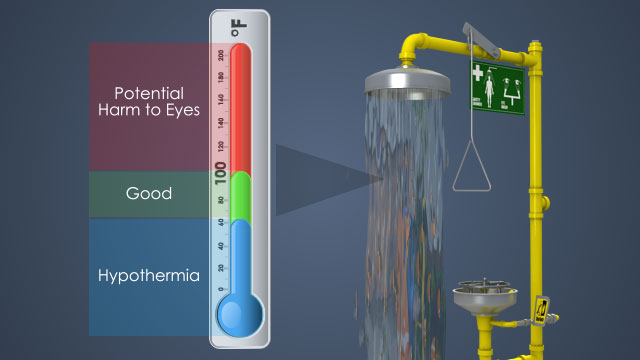


Safety Showers and Eye Washes – Global
Chemicals are frequently used and stored in industrial environments. It is imperative to handle them with care and wear appropriate PPE to avoid exposure. If an accident does occur, however, safety showers and eye washes can be used to cleanse the affected area and decrease the extent of injury. Knowing use procedures, maintenance practices, and the locations of safety showers and eye washes will reduce the risk of serious injury and lead to safer conditions in the workplace.
Request a demoCourse Details
Learning Objectives
By the end of this course, you will be able to:
- Identify potential chemical-related skin and eye injuries
- List commonly used personal protective equipment and how to safely work with chemicals
- Describe common types of safety showers and eye washes
- Explain how to operate and use safety showers and eye washes
- List the steps you can take to help an accident victim
- Detail best practices for the maintenance and testing of safety showers and eye washes
Specs
| Course Level | Intermediate |
| Languages | English |
| Compatibility | Audio, Video, MobileReady, Responsive |
| Based on: | 29 CFR 1910.151 (c) |
Key Questions
What are safety showers and eye washes used for?
To dilute and wash away hazardous chemicals that has come into contact with the skin or eyes; to irrigate or flush chemicals from the eyes or skin; extinguish fires on the skin or clothes; and control body temperatures.
What adverse effects can chemical exposure have?
Skin irritation, poisoning, organ disease, and death.
What can exposure of the skin to chemicals cause?
Temporary dry, red, or cracked skin; chemical burns; permanent scarring; loss of skin color; and permanent damage to the organs.
What can exposure of the eyes to chemicals cause?
Burns; redness; swelling; corneal damage and changes; and blindness.
What is an SDS?
An SDS, or safety data sheet, includes information about the hazards and proper handling procedures of a given chemical at the workplace.
What should one know about the safety showers at a workplace?
Where they are located, when to use them, and how to use them.
How should one use a safety shower?
After chemical exposure, move to a safety shower immediately; pull the handle so the water begins flowing; remove your clothes; wash your entire body for a period of 15 to 60 minutes; have a coworker summon medical attention; don’t rub the affected area.
How should one use a safety eyewash?
After chemical exposure, immediately move to an eyewash station; use the paddles, levels, or pull-lever to turn the eyewash on; hold eyes open with hands to ensure water reaches eyes; flush eyes for 15-60 minutes; keep eyes open and rotate eyes in all directions; have a coworker summon medical care.
How can you help a coworker who has been exposed to chemicals?
Help him or her to a safety shower or eyewash; turn the shower on; help the person remove his or her clothes; helping to hold the eyes open; contacting medical care; and finding the safety data sheet (SDS) to give to emergency medical responders.
Sample Video Transcript
When chemical exposure occurs, one, immediately move to an eye wash station. Two, use either the paddles, levers, or pull lever to turn on the eye wash. Three, hold your eyes open with your hands to ensure water reaches the eyes. Four, flush the eyes for 15 to 60 minutes, depending on the corrosive properties of the chemical. Be sure to keep the eyes open and rotate the eyeballs in all directions. And five, once flushing is complete, turn off the eye wash. Follow these guidelines for eye wash use: never hesitate to use an eyewash if needed. Have a coworker contact emergency medical assistance immediately. If there is no one to ask, rinse for the allotted time recommended in the SDS and then seek medical assistance. If irritation persists, repeat the flushing procedure. Do not use lab or drench hoses as an eye wash. These hoses are typically used for cleaning and may not be sanitary. Never rely on sink faucets to replace an eye wash. Some outdoor eye washes may run discolored water for a few seconds. Never hesitate to use them immediately when needed. Do not the shower for any other purpose that might inhibit the immediate use for an emergency. And beware of slippery floors during and after use.
Additional Resources
- U.S. Department of Labor’s Occupational Safety & Health Administration (OSHA) – www.osha.gov
- OSHA Regulations – https://www.osha.gov/law-regs.html
- OSHA eTools – https://www.osha.gov/SLTC/etools/eyeandface/employer/requirements.html
- US Environmental Protection Agency (EPA) – www.epa.gov
- EPA Resources – http://www.epa.gov/region7/education_resources/teachers/ehsstudy/ehs13.htm
Course Applies To
Demos + Pricing
Learn more about our courses, get pricing, and see our platform.











